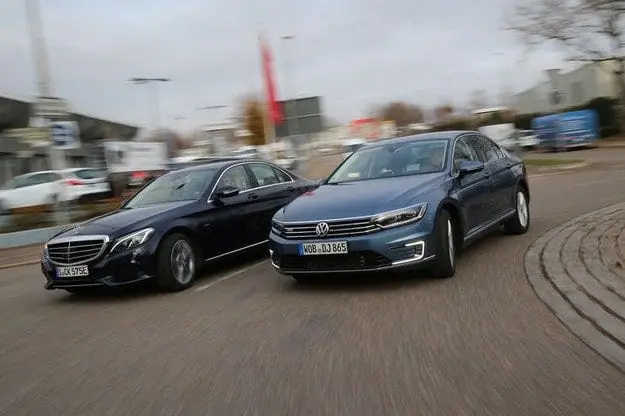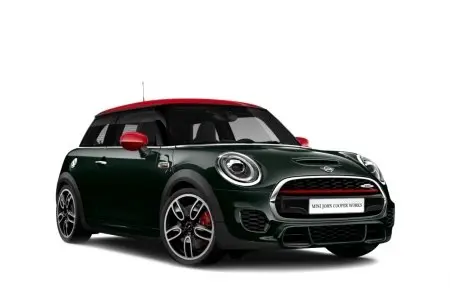
Test drive Mercedes C 350 against VW Passat GTE: hybrid duel

Comparison of two plug-in hybrid mid-range models
Are plug-in hybrids a transitional technology or a highly intelligent solution? Let's check out how the Mercedes C350 and Passat GTE are doing.
What do you do when choosing a car? Well, they usually ask acquaintances who ask other acquaintances what exactly they would choose. Or read reviews on the internet, see comparisons, whether you like it or not. Sometimes small additional factors are added to this equation, such as the size of the garages, maintenance or, in some cases, some levs.
Completely different characters
Time to go. Both cars start smoothly thanks to powerful electric units. Even in the city, you can see that VW has created a car that is more balanced in terms of the timing of moving engines. The gas turbine engine is equipped with a 1,4-liter gasoline turbo engine and an 85 kW electric motor. In practice, they are the same as in the Audi e-tron, but the power of the system is increased by 14 hp. By itself, the electric motor is ten kilowatts more powerful, located in the transmission housing with two clutches - behind the dual-mass flywheel and the clutch separating it from the engine. With a 9,9 kg battery capacity of 125 kWh, the Passat can reach a top speed of 130 km/h and cover 41 km in the purely electric drive test. In this case, the electric machine does not need the help of an internal combustion engine during climbs. The GTE rides quietly and safely over long distances, but has plenty of power and battery capacity for highway driving.
Mercedes combines its two-liter engine with 211 hp. with a 60 kW electric motor. The latter is located in the so-called "hybrid head" in a seven-speed classic automatic transmission with planetary gears. However, its power is not enough for easier climbs, so the gasoline engine comes to the rescue - light and quiet, but enough to be heard clearly.
Because of the above, the C 350 goes into hybrid mode quite often. This is largely due to the smaller size of the lithium-ion battery with a capacity of only 6,38 kWh. By the way, this can also be viewed from the positive side - it takes only three hours to charge it when operating from a 230-volt network (VW takes about five hours). However, unfortunately, on a pure electric drive, a Mercedes only has 17 km - too little to understand all these efforts.
This affects not only how we drive, but also how we score on our test. In both cases, however, the batteries can be charged on the go using the engine, and a mode can be selected in which electricity is saved for city driving. At the same time, Mercedes is using smart technologies to optimize recuperation, including distance-keeping radar – when approaching faster, the C 350 e only starts to slow down with the engine going into generator mode to move ahead of the car. Both compared models connect data from the navigation system to the drive to achieve the highest level of efficiency.
In this regard, the Passat GTE is doing better. The test fuel consumption, based on an auto motor und sport profile, shows 1,5 liters of petrol and 16 kWh of electricity, equivalent to 125 g/km of CO2. The C 350 is far from this achievement with its 4,5 liters of petrol and 10,2 kWh and 162 g/km CO2 respectively. Otherwise, the more affordable Passat outperforms the C-Class - the VW offers more passenger and luggage space, more comfortable boarding, and more intuitive function controls. On the other hand, the Passat's rear-wheel-drive battery not only reduces trunk space, but also changes the weight balance and degrades performance in terms of comfort and handling. The suspension is firmer and the steering is less precise, but still safe when cornering. The C-Class is characterized by a more temperamental and dynamic behavior, balanced and precise handling, and the air suspension demonstrates excellent comfort. However, other C-classes offer all this. The Passat GTE lineup speaks its own, quite authentic language.
CONCLUSION
A clear victory for VW
From a real-life point of view, paying a hefty sum over a standard pure gasoline drive in order to achieve just 17 km of electricity is pointless. VW has twice the mileage. And 41 km is quite enough for the average driver. Added to this are a smaller and more fuel efficient internal combustion engine, a larger battery and a more powerful electric motor. This makes the Passat a better alternative for those looking for a two-in-one vehicle.
Text: Sebastian Renz

